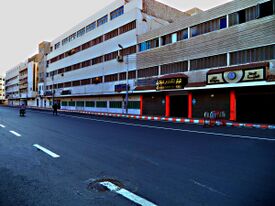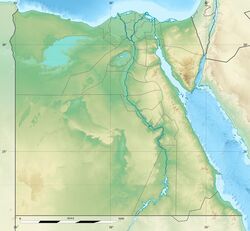Qena
Topic: Place
 From HandWiki - Reading time: 4 min
From HandWiki - Reading time: 4 min
Qena قنا | |
|---|---|
City | |
 | |
| Coordinates: [ ⚑ ] 26°10′12″N 32°43′38″E / 26.17°N 32.72722°E | |
| Country | Egypt |
| Governorate | Qena |
| Area | |
| • Total | 31.60 km2 (12.20 sq mi) |
| Elevation | 80 m (260 ft) |
| Population (2021)[1] | |
| • Total | 252,883 |
| • Density | 8,000/km2 (21,000/sq mi) |
| Time zone | UTC+2 (EET) |
| Area code(s) | (+20) 96 |
| <hiero>M8-G1-D58-X1-M43</hiero> |
| šꜣbt[2] in hieroglyphs |
|---|
Qena (Arabic: قنا Qinā [ˈʔenæ], locally: [ˈɡena]; Coptic: ⲕⲱⲛⲏ Konē) is a city in Upper Egypt, and the capital of the Qena Governorate. Situated on the east bank of the Nile, it was known in antiquity as Kaine (Greek Καινή, meaning "new (city)"; Latinized transliteration: Caene) and Maximianopolis.[3][4] Gauthier identifies Qena with ancient Shabt.[5] Qena meaning in Arabic "very red" of fertile land. [6]
Overview
This provincial capital is located about 95 km from El Balyana and 63 km north of Luxor. It is most famous for its proximity to the ruins of Dendara. It owes its modern prosperity to the opening of the Wadi Qena towards the Red Sea, which is a major traffic route between Upper Egypt and the Red Sea. Tourists traveling between Luxor and the Red Sea will assuredly pass through this city since there is only one good road connection. Qena is noted for its pottery. Qena is also known for its beautiful huge mountains and green nature.
South Valley University has a campus in Qena.[7]
Qena is a large market town on the River Nile situated next to the famous Greco-Roman temples of Dendera. Also on the Nile, Luxor is a long-time tourist hotspot that in large part attracts hundreds of thousands of visitors because of its temples, tombs and location on the site of the ancient capital of Thebes. Ancient Thebes is now a UNESCO World Heritage site.
Qena has one of the highest concentration of Coptic Christians in Egypt (approximately 35% of the total population).
History
In addition to its Ancient Egyptian heritage as the city of Caenepolis,[8] Qena has a considerable Islamic heritage and many unique architectural mosques. Qena has witnessed major restorations, and came third in the UNESCO City Beauty contest.[9]
Climate
Qena has a hot desert climate (BWh) according to Köppen climate classification, with very hot summers and very little precipitation year round. Winters are warm at days, but become cool at nights. The hottest months on average are equally July and August, while the coolest month is January. Luxor, Minya, Qena and Asyut have the widest difference of temperatures between days and nights of any city in Egypt, with almost 16 °C (29 °F) difference.
The hottest temperature recorded was on May 15, 1991 which was 50 °C (122 °F) and the coldest temperature was on January 6, 1989 which was −1 °C (30 °F).[10]
Script error: No such module "weather box".
Transportation
Qena has a network of streets, roads and highways with greenery and flowered pavements. From the city there is a road that crosses the Eastern Desert to port Safaga on the Red Sea.
The United States Air Force conducted classified operations from Wadi Qena airfield from the 1970s to the 1990s, under the code names Coronet Scabbard, Coronel Aspen, Coronet Drake, and Coronet Mallard.[12] The 4401st Combat Support Squadron (Provisional) maintained a near-constant CENTAF presence there. Part of these operations probably included Lockheed MC-130 flights during the Desert One rescue attempts for the U.S. hostages in Tehran in the late 1970s.[13]
See also
- List of cities and towns in Egypt
- Dendera
- Luxor
- Maximianopolis (disambiguation)
References
- ↑ 1.0 1.1 1.2 "Qinā (Kism (fully urban), Egypt) - Population Statistics, Charts, Map and Location". https://www.citypopulation.de/en/egypt/admin/qin%C4%81/2701__qin%C4%81/.
- ↑ Gauthier, Henri (1926). Dictionnaire des Noms Géographiques Contenus dans les Textes Hiéroglyphiques Vol. 3. p. 147. https://archive.org/details/Gauthier1926.
- ↑ Trismegistos, "Kaine (Qena)"
- ↑ Alan B. Lloyd (editor), A Companion to Ancient Egypt (John Wiley & Sons 2010), p. 459 ISBN:978-1-44432006-0
- ↑ Gauthier (1926) p. 147
- ↑ "معنى قنا meaning of Qena" (in Arabic). https://www.almaany.com/ar/dict/ar-ar/%D9%82%D9%86%D8%A7/#:~:text=%D9%82%D8%A7%D9%85%D9%88%D8%B3%20%D8%B9%D8%B1%D8%A8%D9%8A%20%D8%B9%D8%B1%D8%A8%D9%8A&text=1%2D%20%D9%82%D9%86%D8%A7%20%D8%A7%D9%84%D9%84%D9%88%D9%86%20%3A%20%D9%83%D8%A7%D9%86%20%D8%A3%D8%AD%D9%85%D8%B1,%D8%A7%D9%84%D9%85%D8%A7%D9%84%20%3A%20%D8%AC%D9%85%D8%B9%D9%87%20%D9%84%D9%86%D9%81%D8%B3%D9%87%20%D9%84%D8%A7%20%D9%84%D9%84%D8%AA%D8%AC%D8%A7%D8%B1%D8%A9. "qena is extreme red color قنا لون أحمر شديد"
- ↑ "TISC Directory: Egypt - Qena (TICO- South Valley University)" (in en). https://www.wipo.int/tisc/en/search/details.jsp?id=10024.
- ↑ Explore Qena, https://www.tripadvisor.com/Tourism-g1598532-Qena_Qena_Governorate_Nile_River_Valley-Vacations.html, retrieved 30 June 2020
- ↑ UNESCO-Qena [Egyptian National UNESCO Commission], https://whc.unesco.org/fr/listesindicatives/5389/, retrieved 30 June 2020
- ↑ 10.0 10.1 "Qena, Egypt". Voodoo Skies. http://voodooskies.com/weather/egypt/qena.
- ↑ "Climate: Qena - Climate graph, Temperature graph, Climate table". Climate-Data.org. http://en.climate-data.org/location/3676/.
- ↑ William Arkin, Code Names, 325.
- ↑ Thigpen, Col. Jerry L. (2001). The Praetorian STARShip: The Untold Story of the Combat Talon, Air University Press/Diane Publishing. ISBN:1-58566-103-1, p. 196, 213-215.
External links
[ ⚑ ] 26°10′N 32°43′E / 26.167°N 32.717°E
- REDIRECT Template:Upper Egyptian cities
- From a page move: This is a redirect from a page that has been moved (renamed). This page was kept as a redirect to avoid breaking links, both internal and external, that may have been made to the old page name.
 |
 KSF
KSF

